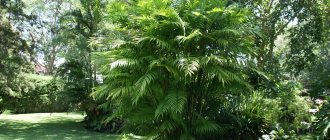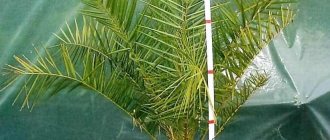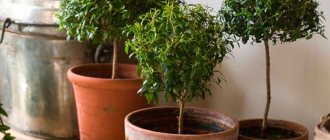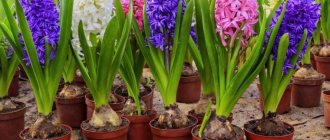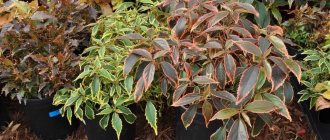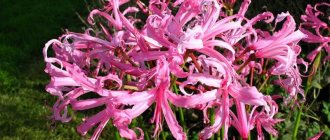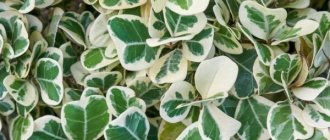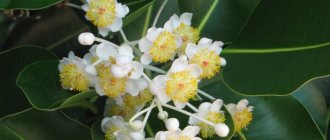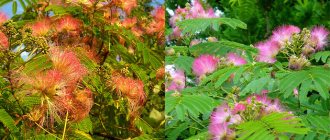Albizia is a genus of the Mimosa subfamily, uniting several species of tropical deciduous shrubs and small trees. The plants are native to several regions, including the Hindustan Peninsula, Iran, Turkey, Thailand, southern China, Japan, and Azerbaijan. Thanks to its ornamental greenery and flowers, albizia is widespread as a greenhouse and home crop in areas with temperate climates.. In areas with mild winters it is grown in open ground.
Botanical description
Adult albizia are densely branched trees or large shrubs up to 10 m high and trunks 15–40 cm thick. The bark is dark gray, finely scaly. The crowns are openwork, wide, umbrella-shaped, their diameter reaches 6–7 m. The root system is superficial, with many long shoots, at the ends of which nodules are concentrated, sensitive to nitrogen compounds. The leaves are dark green or bluish-purple, compound, doubly pinnate . On the central petiole, 17–20 cm long, up to 18 lobes are located oppositely, consisting of 20–30 pairs of small oval plates up to 10 mm long. In the evening, the plates close along the petioles - the leaves seem to close and droop.
In May or June, spicate or capitate bisexual inflorescences of light yellow or white color with many long pink or cream stamens, similar to thin hairs, appear on the albizia. They make the flowers look fluffy.
The fruits are elongated pods 12–18 cm long, with greenish-brown skin. Inside there are seeds - flat beans measuring 7–10 mm.
Albizia is a fast-growing heat-loving species, capable of withstanding periodic short-term temperature drops down to –15 °C, but frosty winters with little snow are destructive for it.
Albizia growing from seeds
Albizia is propagated by seeds and semi-lignified cuttings.
As a rule, sowing in open ground is carried out in the fall, since higher germination is observed at this time. The beans are soaked in warm (40-50°C) water for a day or two to swell, after which they are sown in garden soil.
For sowing at home, mix sand and peat in equal proportions and slightly deepen the seed material into them. The containers are covered with polyethylene and kept under bright diffused or artificial lighting.
The crops need to be ventilated and watered every day so that the soil does not dry out. Shoots may not appear for quite some time. When the seedlings grow a little, they can be transplanted into soil for adult plants.
Main types
The following plant varieties are grown in culture:
- Albizia julibrissin. Because of its fluffy inflorescences, it is often called silk tree or silk acacia. In its natural habitat, it is a spreading tree 7–10 m high with a wide crown. The leaves are bright green on the upper side, lighter and matte on the reverse side. There are varieties with purple and lilac leaves. The flowers are fragrant, large, up to 12 cm in diameter, with thick fluffy hairs of pink, cream and red shades. Flowering period is June and July. Under favorable conditions, the buds remain on the branches until September. As a home crop, Albizia Lankaran is grown as a bonsai or compact tree up to 1.5–2 m high.
- Albizia lophantha. The species is of Australian origin. Low trees up to 4 m tall. The leaves are somewhat shorter than those of Lankaran, the inflorescences are spike-shaped, cylindrical, reach a length of 8 cm, and emit a light sweetish aroma. The staminate hairs are bright yellow or cream in color. They bloom in March or April. The flowering period lasts until August.
- Albizia amara. Grows in Eastern and Southern Africa. A shrub 4–5 m high with a spreading wide crown and openwork leaves. The flowering period begins in May. The inflorescences are capitate, fragrant, 3–5 cm in size, with orange pubescence.
- Albizia saman. A large species native to Central America. A massive tree up to 20 m high with a powerful umbrella crown. The branches are fragile and break easily in windy weather. The leaves are bright green, doubly pinnate, with wider blades than other species. The flowers are bright pink with long, dense stamens and emit a sweet aroma reminiscent of violets.
Trimming and forming the crown of indoor albizia
Many gardeners are afraid to prune for fear of harming the plant. In the case of albizia, these fears are in vain. The plant tolerates pruning well and easily sprouts new shoots from dormant buds.
There are no strict rules regarding the formation of the crown of indoor albites. In this situation, everything depends on the imagination of the grower himself. The main thing is to fulfill the following conditions:
- be sure to pinch the top of the central conductor so that the plant does not stretch into one trunk;
- perform pruning work during the dormant period, when there is no active sap flow - immediately after leaf fall or shortly before the buds awaken.
It makes sense to treat sections with antiseptic drugs - for example, a solution of copper sulfate. It is not necessary to cover them with wax or garden varnish.
Albizia bonsai begin to be formed after the plant is 1 year old. In this case, pruning is performed very deep. At the same time, you can bend the shoots, temporarily fixing them with soft wire so that they take the desired shape.
Application
Due to its decorative qualities and exotic appearance, albizia is used in landscape design. In regions with a subtropical climate, its varieties gradually adapt to unusual winter temperatures: trees are planted in gardens and on the streets. In harsher climates it is a houseplant.
Albizia Lankaran is used in folk medicine . The bark and flowers contain a number of pharmacologically active substances:
- triterpenoids;
- glycosides;
- saponins;
- lignans;
- tannins.
Water infusions and decoctions of albizia have anti-inflammatory, antimicrobial, and sedative effects. They are useful for nervous disorders, insomnia, headaches, tachycardia, gastrointestinal diseases, helminthiases, and genitourinary infections.
During the flowering period, the silk tree is a good honey plant . The bark, due to its pigment content, is used as a raw material for the production of natural dye.
Features of watering indoor albizia
The irrigation regime for albizia usually does not cause any particular difficulties. It should be regular but moderate. However, it must be tied to temperature conditions, seasonal changes and the degree of illumination:
| Relationship between irrigation mode and temperature | Relationship between irrigation mode and degree of insolation | Irrigation mode in active phases of the life cycle | Irrigation mode in the rest phase |
| The higher the air temperature, the more abundant watering should be. | With a lack of light, Albizia absorbs water poorly and evaporates little of it, so moderate watering is needed. | Irrigation is organized so that deep drying out of the earthen coma does not occur. | Irrigation can be rare, moderate, deep drying of the earthen coma is allowed. |
Spraying albizia leaves with water is not required. It is also not necessary to specifically increase air humidity by any other means. Albizia is suitable for normal room humidity.
Albizia is a moderately moisture-loving plant. In nature, it grows on light loams that absorb water well, but do not retain it for long in the root zone.
Growing and care
To cultivate albizia in open ground, you need to choose areas that are well-lit by the sun, protected from wind and strong drafts. Tropical acacia is undemanding when it comes to soil fertility, but does not like clayey, acidified soils. Neutral loose loams or sandstones are preferred for it. Sand and high-moor peat must be added to heavy soil.
Planting is carried out in May, when the soil warms up to 15–18 °C . The seeds must first be soaked for a day in hot water, buried 3–4 cm. The seedlings are placed in holes with a volume twice the size of the plant root system. A layer of stone drainage is placed at the bottom.
Domestic albizia are planted in ceramic pots . For them, a soil mixture is prepared from equal parts of leaf and turf soil, ¼ volume of peat and river sand. You should not choose large dishes - the crop will have to be replanted periodically.
Humidification mode
Albizia loves water very much. It is necessary to water frequently: 2-3 times a week, but try not to waterlog the root system. The top layer of soil should always be slightly damp to the touch. It is recommended to use soft, settled or melted water, heated to room temperature . For watering, take nozzles with fine-jet sprayers.
The air in the room where the culture is kept does not need to be specially humidified. It is enough to water the soil in time and carry out cleaning, removing dust from all surfaces in the room.
Top dressing
In the first year, garden albizia has enough nutrients in the soil. From the second season you can start fertilizing. Fresh manure and other concentrated organic compounds should not be used. It is recommended to purchase complex mineral compositions for flowering plants . Nutrition is added before watering once a year before planting flowers. If the tree develops slowly, fertilizing is repeated at the end of summer.
Indoor albizia are fertilized once a month until the end of the active growing season.
Transfer
Indoor young specimens are replanted annually. The diameter of new pots should be 3 cm larger than the previous ones. Before adding soil, they are washed and disinfected with a strong solution of potassium permanganate. Fresh soil is used.
Transplantation work is carried out at the end of winter or in March, until the plant begins to grow . The root system is carefully lifted with a small spatula along with a lump of soil and transferred to a new container filled with soil about ⅔. Then the roots are carefully sprinkled with the remaining soil. After transplantation, the plant is immediately watered.
Upon reaching the age of 3–4 years, the need for annual transplants disappears. Pots and soil can be updated once every 2–3 years.
Reproduction methods
The most common methods of breeding albizia: seed, cuttings and root shoots. The first method is suitable for garden and indoor crops, but is quite long and troublesome. It is recommended to pre-stratify the material for two months. It can be germinated immediately in a permanent place, in a mixture of sand and peat or in a special agrolite. Sprouts appear within 1–2 months.
Vegetative methods allow you to get new plants much faster . One-year-old lignified shoots are suitable for cuttings. Take their apical parts 10–15 cm long, cutting them at an angle of 45°. The leaves are partially removed, leaving one pair. Before planting in the ground, the cuttings are treated with growth stimulants and deepened 4–5 cm into the sand-peat mixture. Care for them as for adult plants. They develop their own root system in 2–3 months.
Garden crops are propagated by root shoots . It rarely appears in domestic plants. Adventitious shoots are dug up in September, carefully separating them from the mother specimen. The shoots can be planted immediately in permanent places in the garden or grown until the next warm season in pots indoors.
Lighting
Indoor plants are placed on the southwest or south sides. Young specimens will have to be shaded from the bright sun with translucent curtains or blinds. In cloudy weather and evening hours, the lack of lighting must be compensated for by daylight lamps. Direct rays are not dangerous for adult crops.
Garden albizia grow well in open areas and in light partial shade of taller crops.
Temperature
Ideal temperature level for albizia: +22–27 °C. With a gradual increase and timely watering, it is not afraid of hot weather up to +30–33 °C. Indoors, it is recommended to maintain a stable background within +20–25 °C. In summer, in sunny, warm weather, it is recommended to take pots with albizia out into the fresh air.
The plant is afraid of sudden changes both up and down . When switching to winter rest mode, the temperature must be reduced gradually: by 1–2 °C during the day.
Features of winter care
For tropical plants, winter conditions in quite mild subtropics are stressful. Outdoor albizia survive the cold weather quite well under the snow, but severe frosts can destroy them. Young plantings are especially sensitive to them. Before the onset of winter, the soil around the roots must be covered with a thick layer of peat, leaves or sawdust. The crowns are wrapped in thick fabric, thin foam rubber or cardboard. Watering and fertilizing are stopped until March. Mature trees are not afraid of frosts down to –15 °C.
Indoor crops are dormant in winter . They are transferred to a cool room and no longer fertilized. Withered inflorescences and fruits are carefully picked off or cut off. The frequency of watering is reduced to once a month. Albizia that are at rest often shed their leaves even indoors. Before the crop enters the next phase of active vegetation, weak and diseased branches are cut off, sprinkling the cut areas with activated carbon.
Planting in the ground, transplanting
In the spring, once a year, young plants should be replanted. Adult specimens are transplanted into larger pots as they grow.
You can start a beautiful albizia at home by simply buying a ready-made plant at a flower shop, but the process of growing albizia from seeds is much more exciting and interesting.
To do this, you will need a spacious container for sowing, soil, cling film and the seeds themselves.
It is better to take fresh seeds for sowing (aka beans), no older than six months. For faster germination, beans should be soaked in warm water.
Albizia does not have any special requirements for soil, but for seed germination it is better to take loose neutral soil, one third consisting of sand. The bottom of the container must be covered with a drainage layer.
Seeds should be planted in late winter - early spring. It is necessary to deepen the seeds about one centimeter into the container for sowing with soil. In this case, it is recommended to maintain a distance of about 7-10 centimeters between the planted seeds, so that later, when replanting, you do not damage the root system of young plants. The crops need to be watered.
To get the first shoots as quickly as possible, the crops should be covered with cling film. Provide a constant temperature range from +23°C to +25°C and good diffuse lighting. Periodically, the film must be removed to ventilate the crops and moisten them. As soon as the seedlings appear, the film must be removed completely. When the seedlings grow noticeably, young plants can be planted in separate pots.
Diseases and pests
When planted in suitable soil and following all the rules of care, albizia practically does not get sick. Garden specimens are extremely rarely damaged by parasites. Houseplants can become victims of scale insects and spider mites. The risk of pest attack increases if there are succulents in the same room as the albizia. You can get rid of scale insects by wiping the branches and leaf blades with a swab soaked in insecticide. Brown plaques must be removed manually .
The whitish coating and thin cobwebs entangling the leaves are washed off with infusions of garlic, tobacco dust or onion peels. It is necessary to spray the greens daily until the signs of parasites disappear.
Light for indoor albition: natural and artificial
Light intensity is one of the most important factors in successfully growing indoor albizia. In nature, these plants choose open sunny areas. The same place should be found indoors.
“Albizia perceives any decrease in insolation as the onset of autumn and a signal for the beginning of leaf fall. And in houses located in temperate latitudes, there may not be enough light even in summer. Therefore, you should think about purchasing a phytolamp if you want to grow such a plant at home.”
Yu. Klimovich, collector of indoor plants
A combination of natural and artificial lighting may be required even for young albitions that still fit on the windowsill:
| North window | East window | West window | South window |
| Additional lighting is required all year round. | From autumn to the end of winter, constant additional lighting is needed. In spring and summer - in cloudy weather or if there is any obstacle in front of the windows (trees, buildings, etc.). | From autumn to the end of winter, constant additional lighting is needed. In spring and summer - in cloudy weather or if there is any obstacle in front of the windows (trees, buildings, etc.). | In spring and summer, additional lighting is not needed if there is no obstruction in front of the window. In autumn and winter it will be needed in cloudy weather. |
An adult albizia, which stands in the back of the room, will constantly experience a lack of sun. Organizing artificial lighting for a large tree is very difficult. Therefore, control of the height and volume of the crown in this case is a vital condition.
Important! Even in winter, when Albizia enters a dormant period, the plant cannot be kept without normal lighting. This crop requires bright light at any time of the year.
Without sufficient sunlight, even adult albizia does not begin to bloom. Thus, light is one of the main limiting factors for growing albizia indoors.
Possible difficulties during cultivation
Albizia are capricious and sensitive to changes in usual conditions. Excessive air dryness and insufficient moisture levels lead to paleness, early wilting of leaves and falling flowers. The reason may be excessive water hardness or the presence of lime salts in it.
Waterlogging of roots during watering causes them to rot . The development of rot is promoted by insufficiently loose heavy soil and lack of drainage. In such a situation, it is difficult to save a dying plant. You can try to restore it by rooting the remaining healthy shoots.
The appearance of dark spots on the leaves indicates an incorrect temperature regime: keeping the plant in a draft or in a cold room.
Diseases and harmful insects
If the air humidity is too low, then spider mites may come to visit. Due to the fact that agrotechnical rules are violated, Albizia may be affected by a disease, for example, spotting may appear.
Albizia: photo of an indoor flower
Sometimes Albizia shows signs that he is missing something or, conversely, there is a surplus of some substances. Let's take a look at them.
- The buds die off - this means that the soil is very dry.
- Leaves wither - the soil is overwatered or too dry, or the soil is too heavy.
- The leaves become faded - lack of lighting.
- Drying of leaf ends. Coloring them brown means insufficient water supply or very low air humidity.
- Dark spots covered the upper part of the leaves - the presence of drafts or the action of cold air masses.
Albizia Lankaran Pampadur
It grows under natural conditions only in the southern regions of Russia. Different varieties of the plant are found in India, China, Taiwan, Japan, southeast Azerbaijan and other places.
Blooming Albizia Lankaran
Although there are rare cases of acclimatization of albizia in central Russia, it is still better to use greenhouses for its cultivation in these regions. Flowering period - late May-early June.
Origin and appearance
In Europe, this plant has been known since the 18th century. Its name consists of two parts. The first part, “albizia,” is named after the Florentine Filippo del Albizzi, who brought the plant to Europe in 1740. In Latin the plant is called "Albizia julibrissin", "julibrissin" is translated from Farsi as silk flower. Therefore, albizia is also called silk. It is also called silk acacia.
The deciduous tree belongs to the Legume family. Its height can reach 12 m, crown diameter – 9 m. Albizia’s lifespan is 50-100 years. The openwork leaves of Albizia Pompadour have a bright green color and are shaped like acacia and fern leaves at the same time. They grow up to 20 cm in length.
Albizia Pompadour, or acacia
The fruits of the tree are multi-seeded beans, reaching a length of 20 cm. Initially colored green, over time they acquire a light yellow or brown color.
This Albizia variety is grown at home. This is a light-loving plant that loves high air humidity and needs drained loamy soil. Does not tolerate low temperatures well; when grown, it should not be lower than -15°C.
Attention! The tree should not be exposed to direct sunlight in the spring and summer, as this can cause sunburn.
Description of the flower of the plant
Albizia flowers are the main decoration of the tree. They are large, white or white-yellow, collected in panicles. The stamens of the flowers are long and colored pink and white.
Methods of propagating albizia: seeds or cuttings?
Albizia can reproduce both by seeds and by vegetative means. Each of these methods has its own advantages and disadvantages:
- Seed propagation. Albizia seeds usually germinate easily and quickly, allowing you to obtain seedlings with a reserve in case of possible attacks. This method of propagation has only one drawback: if the seeds are not very fresh, you will have to wait 2-3 months for germination.
- Vegetative propagation. Produced by cuttings. Seedlings obtained from cuttings are more resistant to attacks than seedlings. But rooting is very difficult and often ends in failure.
Thus, seed propagation of albizia can be considered more effective. In nature, this plant reproduces only in this way, giving abundant self-seeding around the mother plant.
You can obtain albizia seeds either yourself by collecting them from ripened beans, or by purchasing them from seed producers. For example, they are packaged by a well-known seed company.
Before sowing, albizia seeds are soaked in hot water for several hours, after which they are immersed in light seedling soil. It is better to sow them in cassettes or cups to avoid subsequent picking.
Albizia seeds germinate well at temperatures of +23-250C, provided they are constantly moistened. The soil in seedling containers should not dry out. For reliability, you can tighten the cassettes with film.
Caring for indoor albizia seedlings
After the shoots emerge, the film must be removed immediately. It is extremely undesirable to arrange greenhouse conditions for seedlings with high temperature and humidity. The problem is that during the first few months of life, young plants are very prone to becoming infected with blackleg. Practice shows that hardened seedlings are better able to resist infections and are less susceptible to attacks.
Albizia seedlings must immediately be provided with the following conditions:
- very good lighting, but without direct sunlight;
- moderately warm air temperature (+21-230C);
- good ventilation;
- careful, moderate watering.
Albizia is often sowed in the fall, immediately after collecting the seeds, since freshly harvested seed has the fastest germination. Thus, seedlings are forced to grow in the autumn-winter period, when there is not enough natural light. Therefore, their supplementary lighting with phytolamps is a strictly mandatory condition.
When sowing in spring, there are usually fewer problems with lighting. In this case, it is useful to take the seedlings out onto an open balcony for the summer, having previously hardened them off. Gradual acclimation to direct sun and open air can begin from the second leaf stage.
The first transplant is carried out after the roots of young albizia become visible through the drainage holes. This is done by transshipment, trying to damage the roots as little as possible at this stage.
After transplantation, young albizia are protected from direct sun for 2-3 days, after which they are returned to their previous regime.
